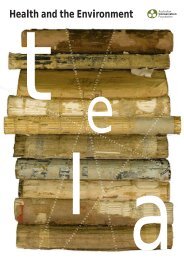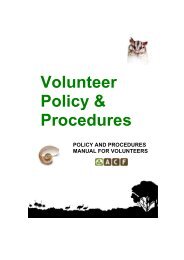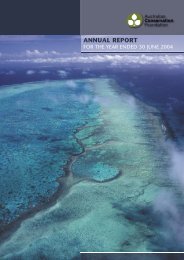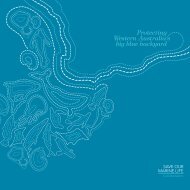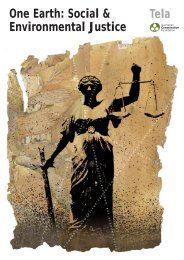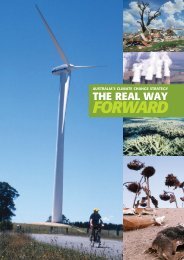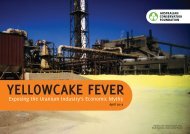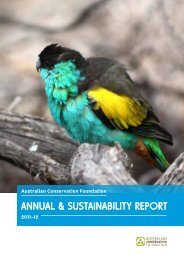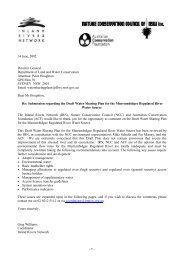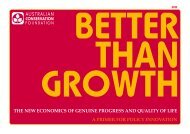pdf of habitat - Australian Conservation Foundation
pdf of habitat - Australian Conservation Foundation
pdf of habitat - Australian Conservation Foundation
- No tags were found...
Create successful ePaper yourself
Turn your PDF publications into a flip-book with our unique Google optimized e-Paper software.
Campaign updatesClimate change is proving the existence<strong>of</strong> a parallel universe. In the real universe, thissummer’s annual melt <strong>of</strong> the arctic ice sheetbroke records, and exceeded the gloomiest <strong>of</strong>all forecasts. Compared to the 1979–2000 summeraverage, an area <strong>of</strong> ice the size <strong>of</strong> Tasmania,Victoria, New South Wales and Queenslandcombined, is missing.In the unreal parallel universe <strong>of</strong> <strong>Australian</strong>politics, Tony Abbott blamed the carbon taxfor the decision by BHP to shelve its massivenew uranium mine at Olympic dam. BHP didnot even mention the carbontax, instead pointing at ‘fallingcommodity prices’ (meaning,uranium is not worth asmuch as it was since Fukushima).It’s impossible to believethese wildly juxtaposed eventstook place in the same week.ACF chooses to work withthe real universe. Campaigningfor more renewables usingtop shelf research, taking itstraight to the politicians, andworking with other groupslike the 100% renewables campaignto ensure that our politiciansface a wall <strong>of</strong> pressure toincrease the renewable energytarget. It’s no easy feat — industrysuits are wandering the corridors <strong>of</strong> parliamenttrying to explain why weakening therenewable target is a good thing. But we havesomething they don’t — the support <strong>of</strong> millions<strong>of</strong> <strong>Australian</strong>s who vote.In the real universe renewable energy is givingold, dirty fossil fuels a thrashing. The price<strong>of</strong> coal went up 500% in the last decade, whilethe cost <strong>of</strong> solar power has dropped by 75% inthe last four years and 45% in the last 12 months.Over four million <strong>Australian</strong>s now have solaron their ro<strong>of</strong>top. In the United States, over 120coal fired power stations have been shut downin the last few years. By next year 850 Millionpeople will be living in countries with a carbonprice. Change is happening in the real universe,and it’s inspiring.For updates visit:www.acfonline.org.au/climate-changeTony MohrClimate changeprogram managerDr Paul SinclairHealthy ecosystemsprogram managerFor updates visit:www. acfonline.org.au/be-informedIf your friends think you’re in the middle <strong>of</strong> reading Australia’slast State <strong>of</strong> the Environment Report (SOE), chances areyou won’t get many invites to dinner or the local pub.Don’t let that deter you. Take it slowly. A good option is tostart by looking at the SOE maps. The results <strong>of</strong> your investigationwill be startling.You’ll see that on one hand, the fertile crescents <strong>of</strong> south eastand south west Australia are critical to producing food and sustainingmillions <strong>of</strong> <strong>Australian</strong>s. On the other, the soils, vegetation,rivers, wetlands and estuaries <strong>of</strong> these crescents are the most degradedand degrading on the continent.Is there a greater threat to Australia’s long-term prosperity?There’s a delusion spruiked by public relation consultants thatsociety has to choose between jobs or the environment. You’llhear that delusion playing out in debates over the Murray DarlingBasin, Australia’s fledgling national network <strong>of</strong> marine protectedareas or Tassie forests.But there are more <strong>Australian</strong>s now who recognise the ‘jobsversus environment’ story as fairy tale. These people might voteLiberal, Labor, National, Green or few in between. They live allover the country. I met a few people the other week on a beautifulNSW estuary trying to do just that.They were working hard to make a big difference to their rivers,towns, farms, forests and estuaries. They were successfullyfinding ways to really value the tangible ‘hold in your hand’ benefitsprovided by their local environment — clean water, healthysoils and lifestyles — and the intrinsic wealth represented in abeautiful landscape and migrating sea turtles.One <strong>of</strong> the optimistic developments out <strong>of</strong> the Rio +20 EnvironmentConference was the production <strong>of</strong> a natural capital declaration.A dozen or so big financial institutions signed on to thedeclaration, committing to integrate natural capital — like Australia’ssoils, wetlands, forests and estuaries — into loan, investmentor insurance decisions.Lots <strong>of</strong> people now seemwilling to value the connectionsbetween ourselves, ourfuture, nature and the promise<strong>of</strong> a decent economy. Findingpractical ways <strong>of</strong> buildingthese connections should be asource <strong>of</strong> great hope.We’ve got to keep workingtogether to secure and replenishthe power <strong>of</strong> these environmentsso they can keepsustaining our livelihoodsand wellbeing. If we’re successfulit could mean that afuture SOE report will showmaps documenting the risinghealth <strong>of</strong> Australia’s fertilecrescents, and make for betterdinner party patter. Thatwould be worth celebrating.30 <strong>habitat</strong>



